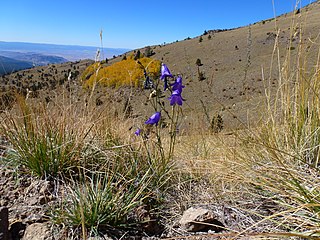
Rosa multiflora is a species of rose known commonly as multiflora rose, baby rose, Japanese rose, many-flowered rose, seven-sisters rose, Eijitsu rose and rambler rose. It is native to eastern Asia, in China, Japan and Korea. It should not be confused with Rosa rugosa, which is also known as "Japanese rose", or with polyantha roses which are garden cultivars derived from hybrids of R. multiflora. It was introduced to North America, where it is regarded as an invasive species.

Luzula campestris, commonly known as field wood-rush, Good Friday grass or sweep's brush is a flowering plant in the rush family Juncaceae. It is a very common plant throughout temperate Europe extending to the Caucasus. This species of Luzula is found on all types of native grasslands, and cultivated areas such as lawns, golf-course greens and fields.

Ipomopsis aggregata is a species of biennial flowering plant in the phlox family (Polemoniaceae), commonly known as scarlet trumpet, scarlet gilia, or skyrocket because of its scarlet red flowers with lobes curving back as if blown back by rocketing through the air.

Ipomopsis is a genus of flowering plants in the phlox family, Polemoniaceae. The annual and perennial herbs it contains are native to the Americas, particularly North America.

Lambertia multiflora, commonly known as many-flowered honeysuckle, is a multi-stemmed shrub which is endemic to the south-west of Western Australia. It grows to between 0.5 and 2.5 metres high and flowers from winter to summer.
Schoepfia multiflora is a species of flowering plant in the Schoepfiaceae family. It is a smallish tree, growing six to eight metres tall, exceptionally to ten metres. It is endemic to Jamaica, where it grows on rocky limestone in the woodlands of the central region.

Lithospermum incisum is a species of flowering plant in the borage family known by several common names, including fringed puccoon, narrowleaf stoneseed, fringed gromwell, narrowleaf puccoon, and plains stoneseed. It is native to much of central Canada and the United States, where it is known from many types of habitat, but particularly piñon-juniper woodland. It is a hairy perennial herb growing from a taproot and woody caudex. It produces a cluster of stems up to about 30 centimeters long. The stems are lined with narrow, pointed leaves up to 6 centimeters long. The slender, trumpet-shaped flowers are pale to bright yellow or gold, and may approach 4 centimeters long. The corolla face is 1 to 2 centimeters wide, its lobes sometimes ruffled. The smaller cleistogamous (closed) flowers are the main producers of seed.

Amsonia tomentosa is a species of flowering plant native to the southwestern United States and northern Mexico (Chihuahua). Its common names include woolly bluestar and gray amsonia.

Ipomopsis polycladon is a species of flowering plant in the phlox family known by the common name manybranched ipomopsis. It is native to much of the western United States and northern Mexico, where it grows in sandy soils such as those of the deserts. This is an annual herb producing a number of horizontal red stems extending outward from the short central stem. Leaves appear at the ends and axils of branches. Each leaf is multilobed, and mostly green but often red-tipped, and less than 2 centimeters long. Stems and leaves are covered with woolly glandular hairs. The long stem branches bear inflorescences of leaflike bracts which are green with sharp-pointed red tips, and tiny white flowers a few millimeters across.

Mirabilis multiflora is a species of flowering plant in the four o'clock family known by the common name Colorado four o'clock that is native to the southwestern United States from California to Colorado and Texas, as well as far northern Mexico, where it grows in mostly dry habitat types in a number of regions.

Zinnia grandiflora is a species of flowering plant in the aster family known by the common names Rocky Mountains zinnia and plains zinnia. It is native to the southwestern and south-central United States and northern Mexico.
This is a list of plants and how they are used in Zuni culture.

Astragalus amphioxys, common name crescent milkvetch, is a plant found in the American southwest.

Campanula parryi, or Parry's bellflower, is a plant.

Croton texensis, is a plant found in the United States.

Cryptantha crassisepala is a plant found in the southwestern United States.

Ipomopsis longiflora, common name flaxflowered gilia or flaxflowered ipomopsis, is a plant. The Zuni people use the dried, powdered flowers and water of I. longiflora subsp. longiflora to create a poultice to remove hair on newborns and children.

Heliomeris multiflora is a North American species of flowering plants in the sunflower family called the showy goldeneye. It grows in Mexico and the western United States from Montana to Jalisco.

Ipomopsis rubra is a flowering plant of the phlox family native to North America from the state of Texas to the province of Ontario, commonly known as standing cypress, scarlet gilia, Texas plume, flame flower, and indian spur. This classification is synonymous with Gilia rubra. This flower is noteworthy for its bright, upturned flowers.















